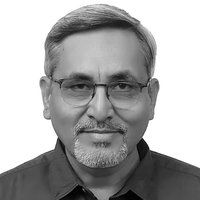Holi days along the border
This week’s festival binds Nepal’s ethnicities and geographies together in a celebration of coexistenceThe fact that the festival of Holi is celebrated on two different days in Nepal this week is itself an indication of how the mountains and plains of Nepal are culturally united.
The full moon day of Fagu Purnima is marked with much merriment in the mountains on Thursday, while the festival of colours is celebrated on Friday in the Tarai. And it would be fair to say that the passion with which Holi in the plains is several times more intense. In fact, along the Nepal Tarai, holi is celebrated on both days.
In many places in Birganj, Janakpur and Rajbiraj, young Hindu or Muslim, Madhesi or Pahadi, celebrate each other’s festivals together. The 2021 census shows that more than half the country’s population now lives in the Tarai, and this coexistence has made the Holi mosaic in the Tarai even more colourful.

The festival proves that as long as the rulers on either side of these borderlands do not mix politics with religion, Nepalis of all faiths and ethnicities can get along as they have for centuries. And example of this are the tradition of folk songs in the Bhojpuri language sung during the Holi festival by people in India and Nepal.
Read also: Many tongues, one voice, Amar Kanta Jha
One such song actually prays for the prosperity of Nepal: ‘Blessed be Nepal, the land of Pashupati which I will decorate with gold and sprinkle Nepal with silver.’ The lyrics of this song are contained in a 1948 Hindi book, Bhojpuri Folk Songs shows that reverence for Pashupati and its role as Nepal’s patron deity is part of the culture on both sides of the Nepal-India border.
The language is a bond that ties the people of these borderlands together, but it is also the festival of Holi that cements the people-to-people relations. The folk songs sung during the festival have been passed down for generations, highlighting the age-old ties.
Holi is celebrated all week this week in Nepal as well as in India with communities gathering in the evenings to sing the ‘Hori’ folk songs. With outmigration, it is mostly older people who take part in these rituals and there are fewer and fewer people every year who can sing the songs.
“The cultural erosion had been happening, but it is accelerating in recent years,” says Harinder Himkar, a historian from the neighbouring Indian state of Bihar. “Because of this, mutual closeness of people in the border regions of India and Nepal have also diminished.”

Holi is a festival of love, intimacy and celebration of spring. It is flirtatious, and represents the changing of the seasons and new beginnings. Which is why the songs sung are happy and optimistic despite the daily grind that the farming communities here are engaged in. It is believed that the deities Krishna, Shiva, Ram and Sita all splashed colours on each other, and humans are just emulating their merrymaking.
Folk songs are by definition old. They are moulded by centuries of experience and knowledge that makes them relevant to this day. No one knows who wrote these songs, or who gave them music, and yet they are immortal.
This particular Bhojpuri folk song sung at Holi, reminds us that Nepal is an ancient country, and it is Pashupati that is the holy bond. Says cultural historian Ramsharan Agrawal from Sitamarhi, just across the border in Bihar state: “The folk song proves that the ties that bind our civilisations together are ancient, and the fact that there are references to Pashupati and wishing prosperity on the people of Nepal shows just how interconnected we were, and are.”
Holi may be celebrated differently on different dates in the Tarai and the mountains, but it is a festival of solidarity between different ethnicities and geographies of Nepal. ‘Holi Friendship Ceremonies’ are held in just about every town along the border.
Just like the song itself says: “May you be happy all year round, like today.”
"आरे धन्य नगर नयपाल हो लाला,
धन्य नगर नयपाल हो ।
आरे जाहवां विराजे पशुपति बाबा,
धन्य नगर नयपाल हो।
आहो कथिये छवइबो में बाबा के मन्दिलवा,
आहो लाला,कथिये छवइबो नयपाल हो
सोनवे छविइबो में बाबा के मन्दिलवा
रूपवे छवइबो नयपाल हो।"
Chandrakishore is a Birganj-based commentator who writes this monthly column Borderlines for Nepali Times.
Read also: Un-Holi Colours, Ashish Dhakal

writer




